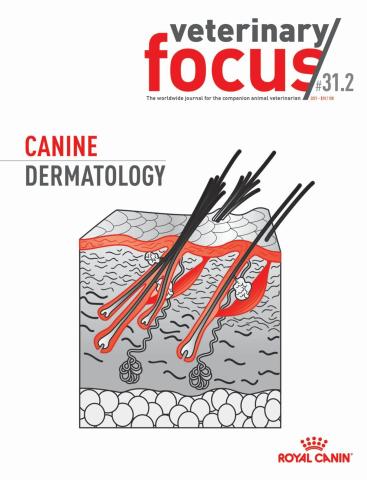
Get access to all handy features included in the IVIS website
- Get unlimited access to books, proceedings and journals.
- Get access to a global catalogue of meetings, on-site and online courses, webinars and educational videos.
- Bookmark your favorite articles in My Library for future reading.
- Save future meetings and courses in My Calendar and My e-Learning.
- Ask authors questions and read what others have to say.
Canine atopic dermatitis and the owner
Get access to all handy features included in the IVIS website
- Get unlimited access to books, proceedings and journals.
- Get access to a global catalogue of meetings, on-site and online courses, webinars and educational videos.
- Bookmark your favorite articles in My Library for future reading.
- Save future meetings and courses in My Calendar and My e-Learning.
- Ask authors questions and read what others have to say.
Read
Treating canine atopic dermatitis can be challenging in itself, but keeping the owner fully engaged can be challenging too, as Pascal Prélaud describes in this short paper.
Pascal Prélaud
DVM, Dip. ECVD
Dr. Prélaud graduated from Toulouse Vet School in 1984 and went on to establish a laboratory which pioneered canine allergy testing. A specialist in veterinary dermatology since 1987, he now holds a senior role at a private veterinary hospital outside Paris, and has also authored many articles and textbooks on canine atopic dermatitis.

Key points
- Good and sustained communication with the owner is key to successful treatment of any dog with atopic dermatitis.
- A clinic should have an established protocol to ensure an optimal approach to every atopic dermatitis case.
Introduction
Canine atopic dermatitis (CAD) is a multifactorial chronic disease that requires the veterinarian not only to deliver long-term care to the dog but also establish and maintain an excellent relationship with the owner. Unlike some other chronic diseases, there is no true consensus on the best monitoring program for CAD, but maintaining continued contact with these cases is essential to ensure the effectiveness, feasibility, and safety of the various treatment options, and this is only possible if the owner is fully informed and engaged. Optimal communication is therefore the cornerstone of long-term treatment, as CAD can negatively impact the owner’s quality of life as well as that of the patient (1)(2). A recent large-scale survey on dogs with CAD (author’s unpublished data, 2013) demonstrated both that owners frequently lack knowledge of the disease (for example, only 4% understood that CAD is a long-term disease), and that there are often shortcomings in the therapeutic options offered by the clinician (for example, only 15% had tried an elimination diet and only 6% had tried cyclosporine).
The first, most essential step with CAD is identifying the disease and getting owners to accept its lasting nature before starting on the long journey involved in monitoring a chronic skin condition. However, there are many potential pitfalls; one study suggested there are seven fundamental mistakes to avoid in long-term management of chronic dermatology cases (Table 1) (3). This short paper provides some key measures that can be easily incorporated into daily practice to ensure that the owner of an atopic dog is kept fully engaged and better informed.

Table 1. Seven common mistakes when dealing with chronic skin conditions (3).
First steps: preparation
Atopic dermatitis is a real opportunity for veterinarians, in terms of medical, technical and interpersonal reasons, but it is essential to understand the disease in order to master the various therapeutic options and therefore communicate effectively. This involves the clinician keeping up to date with evidence-based journals and websites (e.g., www.icada.org) (4), and having access to the appropriate equipment for dermatological investigations, including a good microscope and otoscope. Good “tools” to use during the consultation, such as checklists and even metaphorical diagrams (5)(6)(7), may be useful, and additional communication resources, such as informative websites, can also be helpful. Do note however that most canine atopic dermatitis sites are either too technical or very product- or service-oriented, and it can be helpful for the clinic to have its own web page or blog designed specifically for owners of atopic dogs. In addition, follow-up consultations should always be assigned to the same veterinarian, and the clinic should have a trusted specialist for referral of difficult cases. [...]
Get access to all handy features included in the IVIS website
- Get unlimited access to books, proceedings and journals.
- Get access to a global catalogue of meetings, on-site and online courses, webinars and educational videos.
- Bookmark your favorite articles in My Library for future reading.
- Save future meetings and courses in My Calendar and My e-Learning.
- Ask authors questions and read what others have to say.
About
How to reference this publication (Harvard system)?
Author(s)
Copyright Statement
© All text and images in this publication are copyright protected and cannot be reproduced or copied in any way.Related Content
Readers also viewed these publications
Subscribe
Access to the content of the Veterinary Focus website is reserved for animal health professionals. If you do not yet have a user account with Royal Canin you can create a free account by selecting the New User form. Subscription to the journal is free and issues in your preferred language can be obtained at the Veterinary Focus website.




Comments (0)
Ask the author
0 comments